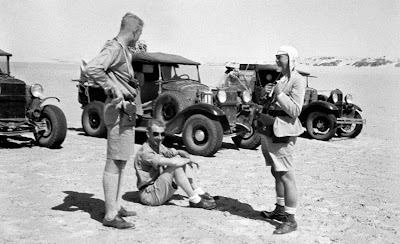
With all eyes on the Libyan desert again I can't resist telling the story of Count László Ede Almásy de Zsadány et Törökszentmiklós, the central character in the novel and film The English Patient.
Dashingly played by Ralph Fiennes he explores the desert, woos Kirsten Scott Thomas, reluctantly helps the Germans in the war and ends up hideously injured and in the care of Juliette Binoche. Lucy chap.
The real Almásy was indeed a Hungarian aristocrat, although not officially a Count. He really did explore the desert in search of the legendary oasis of Zerzura, a copy of Herodotus at his side, by car and aeroplane. He really did find a cave painted with stone age scenes of swimmers. He even claimed to have found Zerzura, but others disagreed.
However Almásy also had what, we might call a colourful, side. He always claimed he was a Hungarian Royalist and not a Nazi, but certainly his Dad felt no qualm about courting the Brownshirts. He was also into ritual magic in a big way and as well as his son he would invite along Unity, the Nazi one of the Mitford sisters.
It is also doubtful whether he would have cared much for the charms of either Ms Scott Thomas or Ms Binoche. Recently revealed letters confirm that he was gay with a boyfriend in the Wehrmacht. We don't know much about this fellow, but as he died after stepping on one of his own land mines it seems Almásy didn't fancy him for his brains.
Contemporary film footage of Almásy, and hints in the memoirs of his fellow explorers, also suggest that Almásy's tastes extended beyond men in uniform, and certainly he did seem to pay a lot of attention to African boys on his adventures.
But if Almásy wasn't exactly a classic romantic hero, he was genuinely a military one.
Just like in the film, he really did sneak German spies into Egypt across the desert. Unlike the Long Range Desert Group, who were doing the same thing in the opposite direction, Almásy was pretty much a one man band, and whilst the LRDG ran like a scheduled bus service, Almásy's one great mission was a wing-and-a-prayer adventure that only just succeeded.
Almásy's men were from the Brandenberg Division. This unit, which was made up of various non-Germans fluant in other languages, often operated behind enemy lines throwing confusion amongst the enemy ranks. Almásy though appears to have got the soldiers nobody else wanted and as well as leading the mission he had to teach them how to drive, repair their vehicles for them as they went and show them how to navigate by the stars when their compasses failed. They appear to have complained all the way there and back.
His route took him 2500 miles from German occupied Libya, across the Great Sand Sea and through the Gilf Kebir plateau, home of Zerzura and the cave of swimmers. Although he didn't know it when he set off, Bletchley Park's Enigma code breakers were onto him from the start. Fortunately though for the fake count, the messages they intercepted only told them where he'd been and not where he was going. As his convoy of four vehicles crossed the desert, patrols from the Sudan Defence Force fanned out to intercept. The were just too late, and Almásy was able to slip through and deliver his spies into Cairo.
He now had to get back.
The SDF was now moving into position to block as the passes through the Gilf Kebir. Unable to get ahead of them, Almásy's slotted his convoy between two SDF convoys and hoped their trail of dust would be taken for another SDF patrol. Once in the Gilf Kebir he then used his knowledge of the labyrinthine gullies to hide until nightfall, before slipping through in the dark and back to Libya.
Although Almásy made it back undiscovered, the two spies didn't fare so well.
Setting up camp in a boat on the river Nile, they proceeded to recruit a network of belly dancers and other exotic characters. Recruitment of these agents was a job the two took very seriously and a bevy of Jewish ladies-of-the-night were interviewed very thoroughly and regularly. As a token gesture towards being real spies they had a radio hidden in the cocktail bar of their yacht with which they tried rather half heartedly to send back messages to HQ, but it rarely worked properly.
Had this been Monte Carlo in the twenties they might have got away with it, but such behaviour couldn't go unnoticed for long in wartime Cairo. British intelligence watched the men long enough to gather all the information they wanted on pro-German Egyptians and then they swooped, rounding up the future President Anwar Sadat in the process.
Almásy tried a few more times to help the Germans, but his plans all failed. Eventually he returned to Budapest where he finally did something really heroic by using his contacts in the Catholic Church to save several Jewish families from the gas chambers.
He died in 1951, with absolutely no idea of how famous he would become.

No comments:
Post a Comment